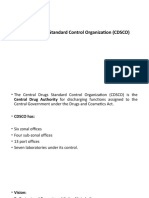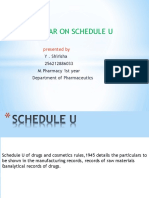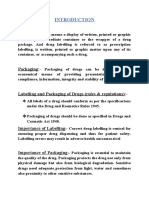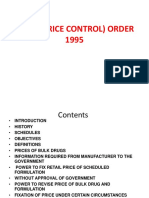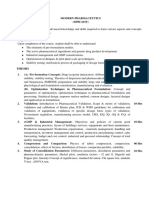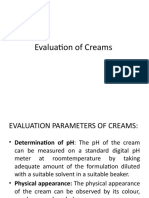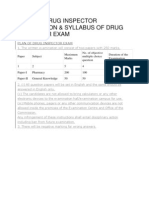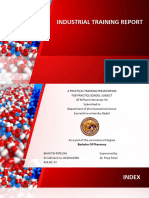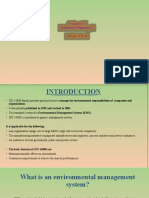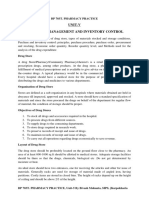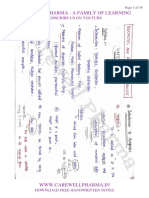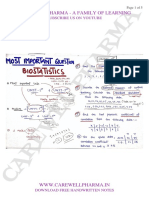0 ratings0% found this document useful (0 votes)
2K views27 pagesPrs-Unit 5
Uploaded by
Manjeet Kumar GuptaCopyright
© © All Rights Reserved
We take content rights seriously. If you suspect this is your content, claim it here.
Available Formats
Download as PDF or read online on Scribd
0 ratings0% found this document useful (0 votes)
2K views27 pagesPrs-Unit 5
Uploaded by
Manjeet Kumar GuptaCopyright
© © All Rights Reserved
We take content rights seriously. If you suspect this is your content, claim it here.
Available Formats
Download as PDF or read online on Scribd
You are on page 1/ 27
LL
REGULATORY CONCEPTS
Neen
‘¢ LEARNING OBJECTIVES +
After completing the chapter, students will be able:
To define and understand basic terms in pharmaceutical regulatory science.
To learn and understand guidance, guidelines, regulations, and laws and acts.
To briefly describe the guidance for industry through Orange book.
To understand the Code of Federal Regulations as an Annual Codification Rules
‘published in the Federal Register by the Executive Departments and Agencies of US
Federal Government.
To unders‘and the concept and purpose of Purple book by the US. FDA of approved
biological products
ee
's about rules of governing and is a concept in governance. It aims to
jpfluence behavior and standards are developed to clarify what practices or goals someone
desire or aims to achieve. In the field of public policy, regulation refers to the promulgation
tof targeted rules, typically accompanied by some authoritative mechanism for monitoring
tnd enforcing compliance. Regulatory policy is about achieving the government's objectives
through the use of regulations, laws, and other instruments to deliver better economic anc
focal outcomes and thus enhance the lives of citizens and businesses. Regulatory policy is
formulated by govermments to impose controls and restrictions on certain specific activities
‘or behavior. Drug regulation is almost universal inthe world. I is based on the premise that
fegulation is needed to ensure that new drugs will be safe and effective, labeled accurately,
and marketed responsibly. The control by the society for the use of medicines and those
wwno dispense and presctibe them isa very old concept whereas the concept that drugs and
the pharmaceutical industry should be regulated isa relatively recent development.
Drug regulation in the United States, as in Europe, has evolved gradually since the
dramatic changes of the early 1960s, There have been no major legislative changes in dug
regulation in the USA since 1962, bt a variety of administrative decisions have significantly
‘modified regulations, A goal of public policy on drugs is to minimize risks; itis an accepted
fact that the use of medications must involve certain risks. Not all risks can be eliminated
through careful manufacturing, rigorous clinical testing, and wise prescribing. The dream of
lifesaving drugs that possess no significant human toxicity is no longer considered realistic
‘The central issues to what extent are government controls over the pharmaceutical industry
6»
Regulation
oO Hee
Phamaceutical Regulatory Science
necessary to active the basic gots ob agOMMaD TST ry. rugs are among »
Fecry cagulbted products n sete, AREuga Ln cer for regulations d
de ert fo protect manufacturers PEO ERAT the use of brand ra
spite to protecting, consumers ooanat. oud DU ge During
yeas rapid scietine and technologkal advances Poe transformed the phar
industry and have brought with them both Nemarkable therapeutic advar
increasing number of potentially hazardous d7ug= with this has come increases
fon the public health aspects of drug regulation.
The primary driving force for increasing
disasters that include sulfaniamide elit 22:
‘as 3 result, government agencies in various
dery authorization to manufacturers for mar
rewarke testing and approval. Although reaurereriE to prove safety and efcac
Become widespread until the 19705, they are now ‘worldwide. These standards
rains in earer laws regulating the marketing of B.S" In addition to premarke!
She approval by the goverment before marketing strict controls have been pia
Tebolng, dispensing, and manufacturing practices. Tew A the costs and the
Grog regulation that excessive regulation Suppresses NeW drug innovation and delays ace
Se aeemeded drags, tere is strong poftical and public support that contro
+> toring by national governments are necessary In tod2Y's ‘world. The question i
benefits can be achieved wt regulation are minimized. There iso n=
Petronger scientfie base for drug regulator pois and a need 6 tunderstand t
“atiomship between social and economic regulation, The multinational
termaceutical industry and the absence of effective control nthe third world indice
acer ipractcal gains to be derved from increased international wnifcsic
standardization of drug policies.
6.2 BASIC TERMINOLO‘
“The use of ineffective, poor-quality, or harmfil medicines can result in th
failure, worsening of the disease, resistance to medicines, and sometimes deat” *
rrcermines confidence in health systems and health professionals, harris:
isnufacturefs, and distributors. To protect public health, governments need te *?
Comprehensive laws and regulations end to establish effective national "9
authorities to ensure that the manufacture, tradey'and use of medicines ae °°
Sppropriately and thatthe public has access to accurate information on medicines
6.2.1 Regulatory Guidance ey s.
Guidance is » general term for suggestions ain
Beret e ae
when needed to assist participa “Regulatory guidance is p!*™
appear unclear or ifements that may be com"
regulatory guidance, set forth policy “sometimes referred ‘°
‘and come in a variety of formats and itory, regulatory, or technice! "
‘en guidance documents '"""
3g regulation has been 2 series of <
fidomide (1961), and clioquin
137), thal
“countries have been empowered to ext
eting new drugs. These regulatio
2—
——— 2 ee
sry winding 0 cnt sare of egatoy text and t inform the
Tepuiations mages) PY. agencies has. often been reported to outnumb aoe
uation fat these documents can help explain, However, itl is ede sbanias
reocedues or devoning this guidance and the steis a a aie
Bart festonc on these docimenis.Culdance decumers ae dexione
prepared for US. FDA staff, regulated industry, and the public that describe the agenc/s
Prerpretation of oF policy on a regulatory issue. Guidance documents nck But ar rot
fimted to, documents that relate to the design, production. labeling, promonery
rronufacturing, and testing of regulated products the processing, content and evaluston 0”
wal of submissions, and inspection and enforcement policies. Guidance documents do
ot create or confer any rights for or on any person and do not operate to bind the US. FDA
tr the public. An alternative approach may be used if such an approach satisfies the
requirements of the | applicable statute, regulations, or both.
‘The US. FDA is empowered to issue other documents which do not have the force of
Jaw and are not obligatory. The main document in this situation 's the "Guidance". This
represents US. FDA's current thinking on the issue in question. It not @ law and is not
ghligatory. US. FDA states on the frst page of every guidance that “Guidances do not create
‘orconfer any rights for or on any person ‘and do not operate to bind FDA or the public’. An
aiternative approach may be used if such approach ‘satisfies the requirements of the
applicable statute, regulations, or both. Guidances may be issued as drafts for comment or
directly 2s final guidance. US. FDA has no obligation to finalize draft guidance and it may
Simply be left as a draft It is generally felt in the industry that following U.S. FDA guidance is
ae use of action. However, 2 company isnot obliged 0 follow guidance ang wi 10!
be cited in a U.S. FDA inspection as failing to follow the guidance. For example, ‘the concept
of Clinical Trial Data Monitoring Committees (DMCs) was ‘issued as guidance in March
2006 with an expiration date which has continually been ‘extended, So DMCs are not
‘obligations. In practice, DMCs are very well accepted and their use is widespread. However,
technically, they are not obligatory. US. FDA may issue other documents such as frequently
‘asked questions (FAQS), white papers, comments, ‘and presentations from the Commissioner
‘or other senior US. FDA officials. These documents may ve opinions on US. FDA's thinking
crt thus are not obligatory unless they clearly reference laws or regulations Therefore,
careful attention must be paid.
For example, guidance is intended to help manufacturers {implementing modem quality
systems and risk management approaches to meet the requirements of the Agency's GMP
erevjations COCR pars 240 and 212) The guidance describes 2 compretins quality
‘Setems (QS) medal highlighting the models consistency wth the ‘cGMP regulatory
RZquirements for manufacturing human and veterinary drugs including biological drug
Tmoducts. The guidance alsoexpzins how manufactures implemen ing such quality
systems can be in full compliance with parts 210 and 212. This guidance is neither intended
to ples nerapiaeens a paretecrer to replace the cGMP requirements
Diao anlage
— Repu ¢
vharstbiital Régiltory Science ssl ~
galy enforceable responsibiig
ish le
US. FDA's guidance documents, do not establish TRA'ahoUd be
fuidences descibe the Agency’ eurent ting On © FE viewe
guano te Aachen eau Ty
the word should in Agency guidances means that some recom
but not required.
6.2.2 Guidelines
There Is afar amount of contusion in cepard to 08 Brann cs sey
pharrrecoigance (PV) requirements In diferent eQi¢he © "Ft is has
saat for companies, especaly those notin eter ie 80% ope on ats
bligetory and what ar best practices. The focus Re. © fon the USA an
countries in the world, there are legal requirements (obligations) en reporting most se
Ss SAE) and some Non-Serious AES (NSAES) from both clinical trials and po:
sraaicrs tthe heath outheniesaieb mumicaricoumeess nets 200 regieren
periodic aggregate reporting of summaries of SAES, some SAEs, and some sort of as
ofthe safety ofthe product.
‘At the most basic level, some legal requirements are broad and give ite deta
; requiting company, sponsor, MA orIND or NDA or ANDA holder. etc fo submit in
‘Case safety reports and aggregate reports. Some countries have very specific require
gn how the submitting company is to handle ths. There is some harmoniza
Cinical tial and post-marketing requirements; however, there are many differ
ourtry to county and region to region even though the ICH has tried to har
Fequirements since 1989. tis important to note that there is not even agreemen:
English language on the speling of the word harmonization (USA) and harmonisation
If anything, theres a divergence away from harmonization now as more and more cour
set up stems for DS and PV with their own local twists. Its the obligation of the
to search out the requirements as well as best practices in every country and market
their products are marketed or studied, It may even be necessary to acquaint ones
the requirements where the company uses @ local licensing partner to market
‘drug as these may impact the company indirectly.
Guidelines are specific recommendations or rules
to be followed in a pxo°
=e ea 0 not carry the force of law, can be more easily mosiee
beeey) pao etna Fl ‘0n what the government's thinking is reg2vsina
eeeeuria ions Following guidelines will help avoid misinterpres"*
tate compliance with laws and regulation ines i Th
RR 5. Guidelines in the EU are differen."
Begotten xl io, The ater oa sf out hey 2
i This is @ comple vege
facto obligatory in DS and PV, Be lex issue and is evolving. In practice, they *°
‘uideine and includes 16 mod cor Patines Good Pharmacovigilance Practic®
lany other documents. The realty is that
‘must be obeyed and an EU/MS inspector.
modules, This is different from ie Tea oration wl cite an industry if defen het
abigatoy. Inthe USA DS and PV men e® dances are not "soft law’ 2d °°
‘Severed by laws, regulations and guidances
imap rear a
65. Regulatory Concepts
1. rch, Mdelines of some developed countries:
Registriert rational Conference on Harmonization of Technical Requirements for
consisting yf Of Pharmaceuticals for Human Use OCH) is 2 unique organization
(EMay, Me f representatives from the regulatory authorities in the European Union
industry iar HUW) and the USA (FDA), and experts from the pharmaceutical
In the three regions in a single forum.
2. USFDA: in
Ri ee, the USA, the regulatory function is performed by the US. FDA through
Radiologie Hern GOES,” espect of medicines and the Center for Devices and
lealth (CORH) in respect of medical devices.
oS Feat en eee te Committee for Medicinal Products for Human Use (CHMP) is
Medicines Agency’ aera ee
medicines. Agency's (EMA) committee responsible for humar
“4. MHRA: In the UK, the MHRA is a
and Social Care which is responsibi
work and are acceptably safe,
In executive agency of the Department of Health
le for ensuring that medicines and medical devices
NMPA: In China, the National Medical Products Administration (NMPA) is the
Ghinese agency for regulating drugs and medical devices (formerly the China Food
and Drug Administration or CFDA). Its responsibilities include drafting laws and
Fegulations for drugs, medical devices, and cosmetics, as well as establishing medical
device standards and classification systems
Health Regulatory Agency: In Brazil, the Health Regulatory Agency, Anvisa,
‘executes Sanitary control of the production, marketing, and use of products and
| Seivices subject to health regulation, including related environments, processes,
" ingredients, and technologies.
Health Canada: In Canada, Health Canada reviews drug products to assess their
” ‘safety, efficacy, and quality
a rule or directive made and maintained by an authority or the action or
‘of regulating or being regulated. A regulation, as it is published, is word for word
mediately, the law. The concept of regulation is different from the use of the word
ion’. Regulations hold the force of law and must be obeyed in the country. The
ary legislation’ refers to treaties and agreements at a very high level in the country.
there is secondary legislation that derives fom the primary legislation. Below this are
»s and regulations. For example, the main legalities that deal with DS and PV are the
ives and regulations. Regulations ean be passed more rapidly and simply than lave
jes requiring, for efample, only the approval ofa single government minister on the
of experts. They Can also be altered more easily, After approval, a regulation has the
fr as the [aw Itself. Many laws charge government agencies to create and issue
lations that have the force of law (Le. regulatory law). For example, inthe case of DS and
duty fells Upon the US: FDA. These regulations do not have to be approved by
h Fs ‘or signed by the President. A proposed new or mended regulation is published in
— Le
Pharmaceutical Regulatory Science 66.
the Federal Register and a time period is usually defined for the public t0 commen, “
review, the final regulation is published by the US. FDA in the Federal Resi,
the Code of Federal Regulations, The time period for review may be very long. Som,
proposed regulation fe withdrawn or never put into effect. Regulations are qi
applicable and binding in counties of origin without any additional national legisla, 7
approval by the governing bodies in the country: "
4 Laws
A aw is defined as an assemblage of rules and regula
must be followed. Law holds its single purview over the larger picture. It ensures that
‘hil strety follow the defined rules and regulations. It more generic in its nate
‘perations and is not that complicated to comprehend. Law can be enforced a5 has ben
ectabished by the regulatory procedures. It is defined to stop malpractices, maintain
crder and most inportanty to protectfundamental rights. A law is an estti
phenomenon under regulation by government authority and holds sovereignty init y
Treludes Act, Rules, and Regulations, circulars, policies governing @ particular s
sphere of activity. In fat it also includes customs and traditions, judicial pronouncemeny
own as case law or precedent. Law is a broad term in which the whole range of proviscrs
in which both procedural and substantive aspects are incided. Law is a living thin
levolves over a period of time that means the law is not corrplete once an Act s pa
‘Act is only a guiding factor, following which the entire law is developed.
Law is a written statute, requirement, ordinance, etc. passed by a legislature and
into law by the executive (where required) at federal, state, and local levels. In
federal law is passed by both houses (The Senate and The House of Representa!
Congress and signed by the President. Investigational drugs (‘New Drugs’) are prim
‘governed by Section 505() [21 US.C. 355] and marketed drugs by Section S05(k) ofthe FO
&C Act, These laws are sometimes very detailed and sometimes only high level. Laws to<3y
are usually written in fay general terms to meet present and possible future neecs Lvs
usually have language that enables the government to issue regulations based on the |v
Passing new laws may require a lengthy process, with the country's legislative branct si
final approval.
Pharmaceuticals involve many parties, including patients, doctors, other healt? wo"e
salespersons, and manufacturers. The field also involves important risks such as peoo'e
suffer or die not only from a lack of medicines, but also from impure drugs
prescribed, or used incorrectly. Thus, laws and regulations are needed. Medicine “= °°"
lens and equations make ear what a manufocturer needs odo to obtain ce
a rue They ding hn asain ancy sto aess both ne mas
rmine if they meet society's needs, A good law also“
tions that are indispensa
7 USA
ves) of
‘administrative bodies to put rules into practi -
Practice, for example, a national drug "2"
‘authority with broad competence, or separate authorities to deal with the various 259° <)
pharmaceutical regulat i
Bippon of mecinas.” Such as the practice of pharmacy, inspection of f9"** i
iol
_teglatory Concent
PesrMaceutical Regutatory Science
62.5 Acts
The Act wa
anes one of the eet ih aes or contol
egies te appintment of our inspectors of Pet Worcs, O00
fa 9 eee tat is approved by the reepetie
are satiate assy or Fale te elena
Baan thing he i oat an eases Te
ss of Law: she foundation on which he aes an Acts employed in specific
uations meaning esabisingrequaon an sn siesfled domains. For example. the
Bian Companies ack wiicr roputews the formation anc functioning of Se
aporations in India. Acts are conditional and specific depending on the dort they hi
Sa tpplied for An Acts represented by the itt is passed for and wal rat Ds enforced
Beet ecomes aw. Acts are mada to rake people avare of certain rues 7 regulations
hat are in place. For example, in india, an Act is originally Bill which proposed by the
tat arnt fiat ad when eget approval fom the ik Sabhe and Fale 30% and the
president, it becomes an Act. Acts are provisions enacted by 2 legislative body or the
Prermment forthe peopl to understand the meaning of speci eamsiane®
of medicines and it
rand Stuffs. AN
India it vs the
The “Orange Book" is the official title of Approved Drug Products with Therapeutic
eulence Evaluations. I's commonly known asthe Orange Book due orange cover
taginal pint version, tis the US. FDA Ist ofall rugs approved te UsA as safe
and effective. Itis also an ‘authoritative source of information on the therapeutic equivalence
GF drug products. In fact, this book identifies drug products approved based on safety and
Gectiveness by the US. FDA under the Federal FDEIC "Act and related patent and exclusivity
Sie is realy avaible for download and ft has search onions avaiable on the
website.
{@) Histor:
Tn the middle of the past century, many states in the USA enacted laws banning the
subtion of drugs in an attempt to prevent the spread of ett! Tt counterfeit drug
products. By ‘the 1970s, there were requests from states to the Federal government for
guidance in creating formularies to Tegulate such substitution. Thus, the US. FDA
anounced its intention to
same active ingredients
by the same route of administration. BE
parable bioavailability when studied under
a
regulatory Concent
Jers NOT to be
‘Pharmaceutical Regulatory Science
ose which the US. FDA con
‘actual or potential bioequivalence problem
‘are not legally substitutable in the Ora
ation i often related 10 pharmacokinetic
solution, disintegration, and absorption
forms rather than safety and efficacy. F
nil fs AB-rated but its extended.reles
Gi) B-Codes: Bcrated Drugs are th
therapeutically equivalent due to
have not been resolved. B-ated "U9
Book States such as New York. This $0
diferences, which aie due to product
metabolism and linked to specie delivery
trample, the calm channel blocker verapa
Perr an covera HS is crated ad thus nt substttale
vcummary of Us. FDA's orange Book Therapeutic Equvalencs Codes
Table 6.
Interpretation
ees
aa No bicequivalence problems in conventions dosage forms.
As | Meets necessary bioequivalence requlteents
Meet ‘AB rated reference dru
Meets ioeauivalence ret
uirements to P|
qo AB2 rated reference drug. |
“ABD _ | Meets bioequivalence requirements
to AB3 rated reference drug
‘AB3 | Meets bioequivalence requirements
asa | Meets boequvalence requirements 10 ABA rated reference drug
powder for aerosolisation.
AN _| Solutionor
‘AO _| Injectable oil solutions
‘ap _| Injectable aqueous solutions.
[at_| Topical products.
BC | Controlied-release tablet, capsule, or injectable
BD | Documented bioequivalence problems. we
BE _| Enterie-coated oral dosage forms. 7
BN | Productin aerosol-nebulizer delivery system.
BP _| Potentiel bioequivalence problems.
‘BR | Suppository or enema for systemic use.
BS _| Testing standards are insufficient for determination.
BT _| Topical products with bioequivalence issues.
BX _| Insufficient data to confirm bioequivalence.
| Requires further FDA investigation and review.
fe
ig not
|
This entry has been evaluated by the US. FDA, but a rating
available for this labeler's product. 4
4
ZZ__| US. FDA standard with no orange book code.
RM ues et
ved rules, and notices Of
ther presidential
[Archives ard
am. and is
rules, propos
Live orders and ot
(OFR), National
ed dally by 6
publication for
ll as exec
| Register
iat dally
‘office of the Federal
Federal Register is updat
pt Federal holidays.
(6a FEDERAL
ede Rage ta
ao a eacean Oe
ecard yn
ocumert imaraion NARAD Te
coed Manny oud HY Oe
sae contents and Organization
Mt Gomera agit gnaaly vided Wes
proposed. ules’, and ‘Notices
putes. and Regulations”, : ces
Feitnicned between title page and ‘abe 6 ‘contents in the front
ack with pages numbered 25
farrcase Roman numerals and cra Teedet aids in the
reer case Roman numerals Frequent, Major proposed and final rues ae published with
tower an thle page and publshed as various pats, 7° p Part I in the back of an issue
thet oe oNotes" section Presidential proclamations one Executive orders are generally
ta ete just before the “Rules and Regulations” section & the back, just before
Per rReader Ais" section Itis to be noted thatthe tie page, table of contents pages and
ipee matter presented in the Federal Register has had varied history. Since 1977
preambles to final an red to contain certain headings and
1d proposed rules have been requit
Prated material including the name of the agency. ‘on the action being taken. &
a brief line
fammary ofthe rule, the effective date of the rule, re due, contact
‘or date when comments af
iMomation, and supplementary information. The supplementaty information frequently
Tyee a uiscussion of the background and need for the regu
ition, and in case of a final
ares t differs from the proposed rule as well &5 responses to comments Ta
sde on the
proposed rule.
revere Regster ie generaly publshed within three working days aftr it's received by
the cat apichf normally about 8-10 days afer the agency releases the mle Whose the
tie, Readers can usuelly find a newly approved regulation on
“approval date maybe even ear
arragency's pubic website before it's pubished in the Federal Register.
agency Pita Procedure Act as amended by the Freedom of Information Act
virat® JGoaments be published in the Federal Register. These include
requires ete and interpretations of general aplabity, statements of general poi
subsariacice and procedure, descriptions of agency forms, rules of the ‘organization,
re of an agency catalan fel organization, end amendments or revisions to
eg. atts of national secrecy o those relating to an agency’ internal
ways been exempted from publication. The Administrative Procedure
management hive al
Jet also requires notice of proposed rulemaking to be published in the Federal Register with
the exception of
{LA substentive rule which grants or recognizes. i
1 Anbu AE 9 oan {an exemption or relieves a restriction.
’As otherwise f
3 Provided by the agency for good cause found and published with the
rule,
ions consisting of
ge sect
ps are
‘These three 9rOu
‘with pages numbered iM
requires that
64d ST ated q
4 the Federal
To asist Federal agencies in preparing oeumetry to be_pubished If te tear
Regist iy penta be tandbook. The Handboo! makes clea
cqutes the OFR has published a Document DFRIPE ry aio attempts 10 Sec one kinds
an id notices. The
pharmaceutical Regulatory Science
tecictions between a final rule and a prOPO#e
posed rules 2
esto eee considered, ts a OU or prop The
, idorod rules #74 Ty or temporary rules hat are effective
rules ted fr later
ication of
De with comme
Handbook also allows for the pul no period
finite pet
immeciately for a short period of fOr ®
consdeaton
6.42 Table of Cont
This section of the Fé {eral Register contain’
i es Se ate ee agen
eu
ian sre oe
jar in the Federal Regi: fare listed in
she Fae ume
cones ve appens et ot
coerce par area Inte unde! the TT Ct
separ Ered in Tissue a0 appee’s Hee, ont
wire, the parts affected Ey the rules and
each days Federal
proposed rules in the issu ie pepe rimbere. Tre Fencer NCS 2008
of the Federal Registe are find specific information in the Federal
Register system, as distinguls! in the preliminary pages under the
Contents section.
1. Introduction
2) istrical Background and Legal Basis ofthe Federal Register
(i) Rules and Regulations
(il) Notices
(iv) Presidential Documents
(v) Corrections
(c) Separate Parts
(d) FR: Research Tools
este et te
is section of the Federal Register
issuance eontalos ny
documents that suggest changes os alas Screw
ee es
a
a mrenensve aiptabela listing by
the documents are arranged
ides the page number
tne document. If Presidential
tiphabetical order in the
Ie a lis: of separate parts
s appearing in the
tents, A list of the “CFR
in the preliminary pages of
where
Documents apoe:
Contents under the hi
ished
making
‘comment on changes. This section also contains documents relating to previously Pu
Proposed rules, extending the comment period, announcing # public hearing,
available supplemental information, withdrawing a proposed rule, or correcting a previously
Published proposed rule I also includes advanced notices of proposed rulemaking, which
describe a problemvsituation and the anticipated regulatory action of the agency. Some
‘agencies voluntarily publish propased changes to procedural rules, interpretative rules, and
‘agency polices to gather public comments. Each document begins with the name of the
issuing agency as heading, the CFR ttle and part(s) affected, and a brief description of the
Specific subject of the document. In some cases, it includes the agency docket number, to
identity the agency's internal fling system. A Regulation Identifier Number (RIN) may also be
included. Instructions for filing comments and the date by which comments must be filed
{ate provided. The terms “rules” and “regulations” have the same meaning within the Federal
Register publication system
6.4.4 Notices Section
This section of the Federal Register contains documents other than Rules or Proposed
Rules that are applicable to the public. Notices of hearings and investigations, committee
meetings, agency decisions, and rulings, delegations of authority, issuances or revocation of
licenses, grant application deadlines, availabilty of environmental impact statements, fling
‘of petitions and applications, and agency statements of organization and functions are
‘examples of documents appearing 1 this section
6.4.5 Presidential Documents Section
This section of the Federal Register contains documents signed by the President and
submitted to the OFR for publication. Presidential documents include Proclamations and
Executive Orders, determinations, letters, memorandums, and reorganization plans. The
documents are compiled annually intitle 3 of the CFR.
6.4.6 Reader Aids
This section of the Federal Register is designed to help the reader find specific
information in the Federal Register system, as distinguished from the finding aids in the
preliminary pages (Contents section) which are more oriented to one particular issue of the
Federal Register.
1. Information and Assistance: Appearing frst is the listing of OFR telephone
numbers to call for specific information.
2, Federal Register Pages and Dates: Ths is a table of the inclusive page numbers
and corresponding dates for the current month's Federal Register.
3. CFR Parts Affected During the Current Month: This is a cumulative ist of CFR
parts affected by rules and proposed rules published in the Federal Register during
the current month,
‘The Government in the Sunshine Act requites that meetings of Government agencies be
the public, with certain specified exceptions. The Act also requires that public
a
cal Regulatory Science _si4 _Heglatny Conese
announcement be made in the Federal Register ofthe time, place, and subject matte ofthe
meeting, the’ brie ‘eh WlepHORN RRB DH Ue suerey oficial to eoiact SG ore
losed to the public
information and whether the meeting open or closed tothe Publ
6.4.7 Corrections Section
This section of the Federal Register conta
Presidential Rule, Proposed Rule and Notice
ins etria conection: of previously publishes
is ments, These corrections ae prepared by
sical or ceial errors made inthe
re ote e cearcca aaet SNSEPOR assed aniynd
prindea ot heer paca (setae jories elsewhere in the issue.
decuments and apperin the appropriate document cates
4.8 CFR Parts Affected from the Federal Regis f i ‘
The Federal Register operation) contains rules and Te
Jost rules are codified in
eral applicability and legal effect. Most J
regulatory documents having gene! PEO fected from the Federal Regt:
Parts
the CFR (opp/colection/f). Browse CFR Bre ccs pate
Copp/tpars) to find final and proposed rues that affect the ce plang
terre Federal Register within the past 24 hours, week, month, of specific date
range, CFR Pars Affected is aso contained in the Reader ‘Aids section of each Federal
Register issue.
6.4.9 Electronic Sourcs
There are @ number of electron!
ic sources to the Federal Register. Govinfo, the officiel
online document repository forthe US. Government Publishing Office (GPO), from 1995 has
Sully bronseabl, searchable, navigable by citation, and has a digitized POF copy ofeach
days Federal Register back to 1936 with authenticated pdf format copies from 1955 |
fomuard It aso has annvel, searchable, and citation navigable CFR issues with PDF copies |
from 1997 forward, FederlRegistergov also contains the same information from 1995 with
easy to navigate advanced search capabilities that can fier by agency, type of document
and other features. Search results on FederalRegistergoy are linked to Federal Redister
documents on Gorlno. For early regulatory documents, the William S, Hein & Co, Inc. has
‘optically scanned all issues of the Federal Register on its HeinOnline service. Lexis and
WestiowNVert also have the Federal Register in POF searchable format from 1936 through
1980 and with Boolean searchable formats of the Federal Register from July 1 of 1980 to the
present. Other commercial services include Bloomberg Law (from 1937), CQ.com (from 1990)
Regscan, Cyberfeds, oisLaw, and DSCS. The Federal government also has Federal Regis=”
‘on GSA's Regulations.gov. As an example, Govinfo uses
three key it ion to
construct predictable Us to documents and detals pages paiforn=t
1. Granule ID for the Federal Register is used to i it
See tate 10 identify the specific document within
a tee {0 used to identity an individual issue of the publication
Publication Date’ used to identity the date and issue of the Federal Register.
Phar
Pharmaceutical Regulatory Science ___egulatory Concepts
[aéenifar | een
Pct wrote ald fe
2=18 | abaon Dat tn YA DD | AGI
cri
Granule 1D | Indivdual Documents s Individual Documents
{FRCoc Number 9.70836 |
Tidaptabael conten TheFogeandconose |
(Package 1D FromMatter 2008-09-09
ont ds omit |
{Package ID}-ReaderAids Reader Aids
£R-2009-09-00-Readerbids |
6.4.10 Metadata Fi
Metadata fields and values can be used to increase the relevancy of searches. Metadata
fields and values are used throughout govinfo for Refining Search, Browsing, Field Operators,
‘Advanced Search, and Display on Details Pages. Metadata fields and values can be entered
into the Basic Search box using field operators. As an example, few field operators available
for the Federal Register are listed in Table 63, along with examples for each metadata field
Using Field Operators some of these metadata fields are made avaliable for use in Advanced
Search using Advanced Search.
‘Table 6.3: Some field operators available for the Federal Register
is and Values
Metadata
Metadata Field Field Operator
Field Display Sr Field Operator Sleseit <|
Name |
Common Fields (apply to most collections) Add collections to search query to search|
only the Federal Register.
Collection | Thecollection towhich the | collection collection‘
document belongs. (fr is used for Federal
‘Typically, the same as the Register).
publication or series.
Government | Thenames of the Government | Government
‘Author ‘government organizations | author author:national
responsible for authoring archives and_ records
assembling the “administration”
document:
Publication | The date the document was | Publish date publishdate:2006-09-
Date fist made available to the 28,
public.
Contd...
Pharmaceutical Regulatory Science
{ Language Tre language code of the
ctiginal document, from
Lo the 150639-2b standard
Former The document 1D of the
PackageID issue or “package” 5
eee cfiginally specified on the
GPO Access website
6.4.11 Finding Tangit
The Federal Register hi
federal working day since 1936 in
wwere republished on better quality paper
Register is available by subscription from
Federal agency and Federal depository ibrar
‘modsidentiir(
formeridentifi
| 007")
modsidentifie:
(@type"formeri
dentifier)
Copies
‘e Government Publishing o1
as been published daily by the
aarp. sues from March 14 1936, to June
spend repaginated in a bound form. The
the GPO and is often distributed in paper
around the country. Few libraries
retire Federal Register set in papet form and sOmeh/n=y continue to bind the daily
ent Fear ederal Regter Index is often retained libraries as microform or
copies, Regional Federal depository libraries, academic law libraries, and Federal
ces ea posible sources for finding older, tne issues of the Federal Regk
Trine has an amost complete historical CFR coleccon online.
Hen coche copes of he Federal Regist fom 1036 10 the present.
(5 t2 citations, ID Numbers and the Unified Agenda
‘nits own documents the OFR cites to the Federal Register PY ‘employing the vol
umber: the publication abbreviation “FR, and the beginning page ‘number on which
aapwent or the requation within the document begins © Wel as the date of publica
Jo erample would be 67 FR 42264, July 30,2002 The Bluebook uses noe detail inch
‘An cram the regulation the volume number, the abbreviation “Fed. REG 25 wel as
publication date and where the documents tobe coed as in Amperio® of Fruits
egetable, 60 Fed, Reg, 50, 379(Sept 22,1995) (to be codified at 7 CFS. Pt 300)". rea
yeaa 2 document by citation method on either Lexis or WestlwNext by simply ust
srr cite method wthout reference toa date or codified cite as in 67 FR 49264
6.4.13 Indexing
“The Federal Register has always been accompanied by an annual Federal R
ni n ral Register Ind
ye Index is organized by agency or subsidiary agency and then within the agency inde
stenoses te tules, and notices, which are t
subjects eva lngp etait araroeeies ean he mn index are scatte
subjects: Gites Be dae agency a ‘agencies dealing with those parti
it age numbers only, but in the bi iat
‘there is a table n in the back of the public
fall Sea See dates. A cumulative monthy issue is also published |
oct diva each year has an annual index. From 1984-1998 "he
the CIS Federal Regiser: ee ate) also published a more detailed semiannual
‘some libraries continue to hold in their collection.
Pharmaceut
*utical Regulatory Scien
Science 617. Regulatory Concepts
6.
4.14 Unified Agenda
The Unifi
ited Agenda as
Uniea grt CoMblt Vila Agenda ate othe pues preggo Tre
rite a2 of Federal Regulatory and Deregultny Actions (nied Agents) provides
Ng on the actions adminis
term. Each edi tions administrative agencies plan to issue in the near and long
that currently hove se sented Agenda includes regulatory agendas from Federal entities
Agenda inclu
Priorities and
for the coming
published in
have regul
lave regulations under development or review. Fall editions of the Unified
ide The Regul
Sea dustry Plan, which presents agency statements of regulatory
year A eermation about the mest snfcantrequtory atte planned
tions ofthe Unified Agenda through the spring 2007 edition were
heir entirety in the Federal Register a ta
Originally the Feder 7
Be aa He leon al Register Act was compiistion of al exiting regulations. As this
Rete fer wc, efit So instesd of» complaton of existing requators the Fede
a fed in 1937 to provide a codification of all regulations every five
The first edition of the CFR was published in 1938 that included all finalized
regulations that were published in the Federal Register from March 14, 1936, to June 1, 1938,
A sixcmember Codification Board was established to determine the precise structure of the
new CFR. A majority of the 50 titles to the CFR have alphabetically arranged in subject
‘categories and title numbers. Supplements to the first edition ofthe CFR were published for
the period beginning on June 1, 1938, to the end of 1938 (in 1 volume), and for the years
41939 (in'2 volumes, 1940 (in 4 volumes), and 1941 (in 4 volumes). There was no 1942
supplement due to war efforts. The new CFR edition that was supposed to come out in 1943
was replaced with a cumulative supplement (in 10 volumes) that covered regulations that
‘afe stil in force and published in the Federal Register from June 2, 1938 to June 2, 1943.
‘Thus, this publication was an adjunct to the original 1938 edition, and not a replacement.
Supplements were ‘again published for the period to the end of 1943 (in 2 volumes)
for 1944 (in 3 volumes) for 1945 (in 4 volumes), for 1946 (in 6 volumes) and for 1947
fin 5 volumes). A supplement was not published for 1948, because preparations wee being
nade for the second edition of the CFR to replace the 1938 codification and the 1943
update.
‘tn 1949, the second edition of the CFR ws published. It included al thos
affect as of Janusty 2, 1949, taken ffom the 2938 edition, the supplements, ave the
fegulation> issued in the Federal Register in 1948. In this edition, some additional
fegulations were added. These regulations were rues of procedure ores received by the
i the Federal Register and considered as officially circulated and applicable to the
e regulations in
sion of
Borer public or a class of the public and made effective on or after January 1, 1949. Each
9 he 1949 CFR, containing one or more titles, also had a subject index and a place at
ook of!
nts were issued
fone back jements wer
to fit a cumulative pocket supplement. Cumulative pocket supp!
concepts
f
eno that 2-new
anmvally for 9 changing selection of books until It te dened apron aus
edition ofa particular book should be published, EY supplement #
finding aids called Codification Guide ois of Sects Aen ul
Th 2963 for some ties and fr all tls 3 the OFF bese ey BOD
Levee Aor ene ofthe CFR elective 00 ANU A Of a ofthe CFR a
rarer teonere, dark bue pape sock 102070 each a EE od
different color onits outside bin re no chery
ges to reg
ing I there 218 2 oe yar the
then a colored paper stock is
bulky in size, an annual repul
sed 50 ein savour Jo
came suppements 008 rn cher tater
Cane read onary gen eat
leafs allows th
Later, it became apparent t©
entire CFR, at the same time, was 2¢
the OFR has divided the titles of the CF a each er
Staggered quarters of the yar. Thles 1-10 37% Revised effectively on January y
gga ae pzed etcvey on Apt 1 of SACO Ne “ites 2-41 are revised eee
ses of each yer and ties 42-50 are revised cfrectvely on October 1 of each Ys
‘5.4 Contents and Organization
re CER does not contain preambles Proposed
saterments contains ust the finalized and effect Te
sare offcialimerpretations of supplements to those Te
pject matter iio CFR titles, chapters. parts 2nd sections. Generally, an agency's rules af
‘ilelaced under one tle or chapter. However sections ¢t arts of the CFR that have been
a raceme frequently reused 2s 2 publishing vehicle For ne unrelated regulations. CFR
ra ai blghed annual according to a staggered schedule and finalized rules in the
ens a Register update the annval rules published in the CFR. Title 3 of the CFR contains all
Feet nial proclamations and Executive orders issued that year and are not updated
Ihe agency rules A Codification of Presidential Proclamations and Executive Orders (ol. 1)
was last issued ir 1850 and covered the period 11945-1989, The OFR on its website now
ae ee yr dos te al enc
ion table for all executive
roa aed 1937 to the present. Now the Executive orders on the OFR site are also
CFR: Table of Contents
Title 1 - General Provisions
Title 2 - Grants and Agreements
Title 3- The President
Title 4 - Accounts
Title 5 - Administrative Personnel
Tile 6 - Domestic Security
jishing yearly
ks were
ulations in ¢
‘older edition. Although
instead of @ through
ine how a regulation
pat revising the
« ecara age (OFF) hat TP
ne Fer Bom Ocobet 1 172
the Once of #
each group being revised in
dministratively U
rules, notices, or even general policy
les of Federal agencies as well as any
Jes. These rules are organized by
Tile 7- Agriculture
Tile 8 Aliens and Nationality
Title 9- Arima and Animal Products
Tile 10- Eneray
Title 21 - Federal Elections
Tite 12- Banks and Banking
Title 13 - BusinessCredit and Assistance
Title 14 - Aeronautics and Space
Title 15 - Commerce and Foreign Trade
Title 36 - Commercial Practices
Title 17 - Commodity and Secures Exchanges
Title 18 - Conservation of Power and Water Resources
Title 19 - Customs Duties
Title 20 - Employees’ Benefits
Tile 21 - Food and Drugs
Title 22 - Foreign Relations
Title 23 - Highways
Title 24~ Housing and Urban Development
Title 25 - Indians
Tile 26- Internal Revenue
Title 27 - Alcohol, Tobacco Products and Firearms
Title 28 - Judicial Administration
Title 29 - Labor
Title 30 - Mineral Resources
Title 31 - Money and Finance: Treasury
Title 32 - National Defense
Title 33 - Navigation and Navigable Waters
Title 34 - Education
Title 35 - Panama Canal
Title 36 - Parks Forests, and Public Property
‘Title 37 - Patents, Trademarks, and Copyrights
Tle 38 - Pensions, Bonuses and Veterans’ Relief
Title 39 ~ Postal Sevice
Title 40 - Protection of Environment
‘ile 41 ~ Publi Contracts and Property Management
Title 42 - Public Health ainns
Title 43 - Public Lands: Interior
Pharmaceutical Regulatory Science 620
Title 44 - Emergency Management and Assistance
Title 45 - Public Welfare
Title 46 - Shipping
Title 47 -Telecommunication
Title 48 - Federal Acquisition Regulations S)
ystem
Title 49 - Transportation
Title 50 - Wildlife and Fisheries
6.5.2 Electronic Sourc
There are a number of electronic soures
es to the Federal Register and the CFR. It
the List of CFR Sections Affected. In addition, the site thas nearly all past editions of
have citation retrieval capability for sections in the current CFR. Other commercial
include Bloomberg Law (from 1937), CQcom (from 1990), 2s well as Regscan,
Luislom, aed DSCs, GPO also maintains an up-to-date “Electronic Code of
Regulations (e-CFR) service which presents CFR sections in their current form
recent amendments from the Federal Register already incorporated. The e-CFR sel
vavdeted daly and aso allows to separately viewing appendices and supplements
sats instead of having them tacked together onto the concluding final section of a
the CFR. Other electronic CFR services ate LevsNents, WestlowNert, Bl
TheLowNetret.
6.5.3 Finding Tangible Copi
Regional Fedral depository ibraris academic lw libraries, and Federal agency Wi
are all possible sources for fining older, tangible issues of CFR, but they may n
complete paper sets or only have certain CFR tits.
6.5.4 Citations, ID Numbers and the Unified Agenda
Cations to the CFR in the Federal Register are cited with the ttle number
abbreviation CFR, the word “part” or the symtol‘S for section, and the number oft
‘or section, asin "12 CFR part 220" of “12 CFR $2201." The Bluebook citation met
Similar tothe above, but it requires the reader to use periods in °C.R." and the issue
the CER title a5 well asin 12 CFR. pt. 220 (2014). By just using a simple CFR par or St
Citation, a curtent (or near current) CFR document can be obtained on Westla
Lexis as in “12 CFR 2201," CFR titles have chapters corresponding to different age
bureaus, For instance, 12 CFR. Ch. Il corresponds to regulations published by the
Reserve Board. The information below a CFR section is referred to as a paragraph
peragraphs, as in 12 CFR 220.1(b)2)
6.5.5 Indexing
ne eerian ‘lag {an annual CFR Index. The “Index” portion
felts the: poral ahr? subjects with references to CFR parts. Partic
parallel authorities’ section, which provides CFR cites to regulations
621 Regulatory Concepts
e
eg tat are organized by USC. section US. statute page number,
momber, and Executive order number. From 1949 to 1963 4
atetbshed in the back of each book oF tre CFR, which sometimes
gencies have prepared 27
was pul
Presa a mtile tiles of the CFR, and since 1975 a few 2
rered oe rat is published slong ‘with their regulations in the CFR. The Index is also
agen (24 anally
nding AICS
par i reer and mbes Finding Aids. The “Findings Aids" portion is
re vip folowing es: "Uist of Agency Prepares
"ist of CFR
ad re out Seton
fegstiog nc! (CFR Volumes.” "Parallel Tabl
teeubchapters, and Parts” and “Alphabetical List of
annually.
le of Authorities and Rules:
‘Agencies Appearing in the
= rnding Aids a0 reproduced
qs.7 List of CFR Sections Affected
equa in 1950 by being plac eet supplements to the 1949
ff the CFR, the List of CFR ganized by CFR tile and part
contains page references t0 th that publish changes
stand proposed resi the CFR The Sans proposed
bere revocations, of nowy, estabished reouliors published. in the Federal
apt The LSA makes it easter or esearch ‘tack the development and ascertain the
Retraasof particular reguations. Before 1964 SA ‘simply called List of Sections
Iifesied and contained iti information on how TER was affected. Since 1964 LSA has
Sy cection-by-secton information on how CFR parts ott ‘affected. Beginning in 1963,
Fonthly and annual issues of the LSA were publihed instead of being inserted inte
“December issue of the LSA would
pocket supplements The cumatve January
Be ted othe anrvlissue forthe volume. 101972 titles ofthe CFR began to
Pe plshed with staggered effective cates and fey TT certain monthly issues of the
Beir desonated este annual sue fx cerain ies CCR (December issue
Brees Mant ue for Tiles 37-27, June sue for es 72-0 ‘and September issue
formes 42.50), Four complations of the ISA. have, Bar, published by the GPO
gt one ion 1968, 1864 to 1972 @yos), 73 1985 (4 vol), and 1986
Hees ene wlumes are orgeized by CFR te and then PY Yor within each title
aly teatzad rls to CFR sections are included, which note Hs ET taken and the
Conesponding page numbers in the Federal Register. The 1986-2000 LSA compilation is
‘Govinfo from 1997 to the present.
palate decal cn Govinfo. As aso available on
Po oo tiach sue ofthe daily Federal Register, theres 2 cumulane=
kao Cho affected that month. A current 1 cate ist forte mont
on sana faoarciora register and earlier monthly cumulative Ists can be
found Se Bao» Federal Reiser was issued Thus ts possible to
sec a ana towns the annual CFR together with the most
et EEE enn event Federal Register. Also, certain CFR
Teasigned or removed, including titles 2, 6,10, 13, 34, 40,44, and 48.
ee
Pharmaceutical Regulatory Science
ace itn ee
21 CFR is widely followed in pharmaceutical companies and has Gre
wu in pharmaceuticals. Tile
digital documentation. 21 CFR Part 11 is well kno
portion ofthe CR that governs fod and drugs within the USA for US. FOA t
Fafa Adie en EAL and the Ofc of Nationa Org Conte RAG
Inconssts of thre chapters each pecliing in codes hese orgeniZtoG
Chapter I: Food and Drug Administration
CChapter It Drug Enforcement Adminstration
Chapter I: Offce of National Drug Control Policy
21 FR is generally known for 21.CFR Part 11.¢
parts that have diferent guidelines to be followed in indistes
Chapter This chap is pecealy meant or he US. FDA Hs been derived
the Federal FD&C Act. This chapter has many ‘sections dealing with various guidelines. ~
Part 11: Deals with rules concerning digital signatures and electronic
maintenance, The next few sections deal with clinical trials. It's some of the
prominent sections are:
(a) Notable Sections:
11 Electronic Records and Electronic Signature Related
0 Protection of Human Subject in Clinical Trials
+54 Financial Disclosures by Clinical Investigators
56 Institutional Review Boards that Oversee Clinical Tals
'58 Good Laboratory Practices (GLP) for Nonclinical Studies
{by The 100 saris: deals wit he listing of rutstional values of various food items wi
sip sections concentrating on nuttinal elements such as trans-fat. The rest ofthe 1
sae deals with specie food products such as inant formula, food additives, cit
supplements etc
101.9 Nutrition Facts Label Related
(612) Requirement to include Trans-Fat Values
(©8)iv) Vitamin and Mineral Values
106-107 Requirements for Infant Formula
110 et seq. cGMPs for Food Products
111 et seq, GMPS for Dietary Supplements
170 Food Additives.
psa rar
a eter er susie! wd gets 9 ore
202-203 Drug Advertsing and
210 et seq. cGMPs for sit hy ee 1
lectronic signatures, but it has dif
IER Regulatory Serene e_
NO et
320 e580 Requirements for New Dros
28 et sea. Sp
tea a eal OTC Drugs
e300 series: 1 eas special with drugs and medications meant for a
Braces related tothe vteinay since
510 et sea, New animal di
556 Tolerances for esiues of drugs in
for residues of drugs in food animal
(e) The 600 series: it covers biolo eae ia : A: oh tural such as
and man-made such s vaccines, re
(A) The 700 series: ;
7 series: It involves everything from labeling to research involving cosmetics
01 Labeling requirements
‘The 800 series: It is
Bre sit ent or nai cars their hazard warnings, approvals needed
inching such a product, and other safety regulations for such devices
803 Medical Device Reporting
£814 Premarket Approval of Medical Devices
£820 et se, Quality system regulations (analogous to cGMP, but structured like 150)
‘860et seq, Listing of Specific Approved Devices and how they are classtied
(hy The 900 series: It regulates the devices and the standards necessary for devices used
for mammography.
{) The 1000 series: Covers radiaion-emitting device (ec phones, lasers, -"@Y
ator) requirements enforced by the Center for Devices and Radiologica Health. It
‘also talks about the FDA citizen petition.
) The 1100 series: Includes updated rules deeming ere that statutorily come under the
defiition of “tobacco product” to be subject to the Federal FDRIC Act as amended by
the Tobacco Control Act. The items affected include e-cigaretes Hookah tobacco, and
nimals and
blood and lymph
pipe tobacco.
(4 The 1200 series: Consists of rules primary based nv other than the FDAC Act: 240
Rules promulgated under 361 of the Public Health Service Act on interstate control of
communicable diseases, ‘such as:
Requirements for pasteurization of milk.
«Interstate shipment of turtles as pets.
1) tnterstate shipment of Arcen rodents that may cary monkeyPot
«sanitation on interstate conveyances (ie. airplanes and ships).
11271 Requirements for Human Cells, Tissues, And Cellular and Tissue-Based Products (ie.
the cGTPs)
Chapter Il: This part of the 21 CFR concerns with the marketing, sale, and use of
controlled substances and scheduled drugs. It iss the various drugs and substances that
coed to be controlled and would require special documentation for buyirg and selling,
Pharmaceutical Regulatory Science 6.24
Notable sections:
1308 Schedules of Controlled Substances
1308.03(a) Administrative Controlied Substances Code Number
1308.11 List of Schedule I drugs
1308.12 List of Schedule II drugs
1308.13 List of Schedule Il drugs
1308.14 List of Schedule 1 drugs
1308.15 List of Schedule V drugs the implementation of a drug
Chapter It primarily deals wth rules concerning the IMP ONT os that are ng
environment in government workplaces. These include lists Of OCT os have ag
allowed and the proper tests and procedures that employe a soi
undergo. algo puts down the rules as to how often such rests ave
Notable sections: 1405 Government-Wide Requirements for Drug
IND Application Process Regulations:
21CFR Part 50 Protection of Human Subjects
ACER Part 54 Financial Disclosure by Clinical Investigators
ACER Part 56 Institutional Review Boards
24CFR Part 58 Good Lab Practice for Nonclinical Laboratory [Animal] Studies
21CFR Part 201 Drug Labeling
2ICFR Part 312 Investigational New Drug Application
2ICER Part 314 INDA and NDA Applications for FDA Approval to Market a New Dru
(New Drug Approval)
21CFR Part 316 Orphan Drugs
Though the Title 22 of the CFR and its recommendations are quite extensive there af
still some ambiguity and gray areas that need to be smoothened, but all in all, it hi
limproved over previous versions and has been updated to clear issues and confusions face
in previously unclear sections. It is necessary and recommended for US. FDA regulato
compliance.
al products 3s
riod that is often 12 years from the first date of eae
Phan
TRemaceutial
The py
olor’ PURE Book is. no
incro3eal products hewn actual book; it is @ nickname applied to electrone lists of
wranng any Bosman eee the US: FDA under the Public Heth Service (PHS) Act
Tie ehalabe as two sera erhangeabl olga products, The Pup Book rial
tinge 08 US. FDA icone te of US. FA cers oli product equated Dy te
Lncetand if baie nt 0° rot rege by he CER To at 0
Terence product carey suc at bE aproved by US, FDA under the PHS At wth 8
ity for a given rep Rtoved biological product) and to help identity if there is ary
a, i Teadersnye oe Product. This reference guide assists pharmacists in
TTaCOVigilance progran fo( ESSAY. t0 develop and implement _aporopriate
2014 and is updat ie available on the US. FDA website wwwmusf ov in
Boat bioksica pea. Pte Petia. Te sine the folowing inraation
5 ation besimiar produ nd imerhangeabe
cs ate grouped under the ‘reference, peducl Wo unin tec ee
einen
ised allergenic, cellular and gene
a er lular and gene therapy, hematologic, and vaccine products
Fig. 62: tustrative Purple Book on U.S. FDA Website
d biosimilar products are US. FDA-approved and licensed under the Public
PHSAY, while small molecule drugs are US. FDA-approved and licensed
‘Act. Biologics License Application (BLA) submitted uncer section
roved and licensed after appropriate efficacy and safety data have
mitted under section 351(K) of the PHSA is approved for licensure
ion of its similarity and absence of clinical meaningful
CC
Pharmaceutical Regulatory Science 676 __ Regulatory Concepts
uct, has beer
difference to 9 351(8) product, considered the referenced biological product
‘ensures that 4
demonstrated. The exclusivity period for the reference product essentially ensures
351(k) application may not be submitted until 4 years after the fist licensure of the
reference product and the Us, FOA may not approve # 35100) appiation unt 12
after the licensure ofthe reference product. Ferard the
‘The Purple Book is @ compendium of US. FDA-approved biological product ner
bioumiar nd interchangeable produc. i snfar tthe range Book The book as
includes the following information about biologics:
(@) BLA Tracking Number
(b) Non-Proprietary Product Names
{© Proprietary Product Names
(@) The date the Product was approved in the Market
(©) Date ofthe First Licensure
(0 Whether the Product is Interchangeable () or Biosimilar(B)
(g) Reference Product with an Exclusivity Expiry Date
(h) Whether the Product is Withdrawn from the Market
Areference biological agent: This entity denotes a product defined under section
351,44) of the PHSA as the single biological product licensed by the US. FDA under section
35%(@) of the PHSA against which the biosimilar biological agent was evaluated jn its
application submitted under section 351(K) of the PHSA.
Abiosimilar agent: It is 2 product described under section 351()(2) of the PHSA as
bighly similar to the reference agent. A biosimilar agent that is licensed by the US. FDA
under section 351(a) of the PHSA has been demonstrated to have no clinical differences
between the biosimilar and the reference biological agent with regards to potency, purity, or
safety.
‘An interchangeable biological agent: It indicates a product defined under section
351{K(4) of the PHSA as a product licensed by the US. FDA under section 351(k) of the
PHSA that is a biosimilar and predictably produces the same clinical outcome as the
reference biological agent in a given patient, Additionally, classification of interchangeabilty
indicates that administering the product more than once to the same patient showed 3
Similar efficacy and safety profile that remained unchanged or diminished even when the
‘administration was alternated between the biological agent and the reference product.
Blois wince the 12-year exit, pus pedir excuse
a 1 (plus: lusivity if any. The Purple Book
ne include information on ‘orphan drug exclusivity, nor will it contain a haere
g srmation. Although the US. FDA has created the Purple Book for assistz h
iosimilar product substitutior Pe
; sing state-specifi
uine multiple aspects ofthe substitution process, including commonsense aS
‘and recordkeeping requirements,
cS REVIEW QUESTIONS
1. whats the significance of reguiation in pharmaceutical affairs?
2. What do you mean by rules and regulations?
3. ‘Mhatis the difference between guidance and guidelines?
4. What s the meaning of acts and laws? In what sense they differ from each other?
5. Uist quidelines followed in some of the developed counties.
6 Whats orange book? Write about is historical developments.
7.
8
8
Discuss the contents of orange book
What are the therapeutic equivalent codes? Enlist and describe them.
Whats the federal register? What are its objectives?
10. Wite about the contents and organization ofthe orange book
11. Enlist components of Table of Contents in orange book
12. What do you understand from the Proposed Rules and Regulations Section in the
orange book?
433. Comment on Reader Aids in an orange book
34. Enlist Electronic Sources of orange book
45, What is the Code of Federal Regulation? What are its objectives?
“16. Write about the historical developments of CFR
47 Discuss the contents and organization of CFR.
4B. Wrte a note on the List of CFR Sections Affected in CFR
49, Discuss the CFR in Pharmaceutical
20. What i te Purple Book? What are its objectives?
2L Define the terms:
() Areference biological agent
_@ Abiosimilar agent.
i) An interchangeable biological agent.
tote
You might also like
- Central Drug Standard Control Organisation (Cdsco)No ratings yetCentral Drug Standard Control Organisation (Cdsco)17 pages
- Practice School Format Bp706 - Final - MpcpsNo ratings yetPractice School Format Bp706 - Final - Mpcps9 pages
- CDSCO VS INDIA: Differences in India Vs Global Pharmacovigilance RequirementsNo ratings yetCDSCO VS INDIA: Differences in India Vs Global Pharmacovigilance Requirements5 pages
- Unit 4, Instrumental Methods of Analysis, B Pharmacy 7th Sem, Carewell PharmaNo ratings yetUnit 4, Instrumental Methods of Analysis, B Pharmacy 7th Sem, Carewell Pharma27 pages
- Quality Control Tests For Containers, Closures and Secondary Packing Materials67% (3)Quality Control Tests For Containers, Closures and Secondary Packing Materials14 pages
- 5.kajol Patil (Feedback Reguated Drug Delivery System) Final123No ratings yet5.kajol Patil (Feedback Reguated Drug Delivery System) Final12322 pages
- III.e.medication Order and Communication SkillNo ratings yetIII.e.medication Order and Communication Skill28 pages
- Unit 2 P Jurisprudence 5th Semester Carewell PharmaNo ratings yetUnit 2 P Jurisprudence 5th Semester Carewell Pharma24 pages
- Bpharm Sem 6 Quality Assurance Ques PaperNo ratings yetBpharm Sem 6 Quality Assurance Ques Paper3 pages
- Scale Up Process and Post Approval ChangesNo ratings yetScale Up Process and Post Approval Changes25 pages
- ISO 14000: Environmental Management GuideNo ratings yetISO 14000: Environmental Management Guide8 pages
- Ip II 7 TH Sem Dbatu Last 4 Question PaperNo ratings yetIp II 7 TH Sem Dbatu Last 4 Question Paper4 pages
- Unit 1, Biostatistics and Research Methodology, B Pharmacy 8th Sem, Carewell Pharma PDFNo ratings yetUnit 1, Biostatistics and Research Methodology, B Pharmacy 8th Sem, Carewell Pharma PDF39 pages
- Practice School Report, Roll No - 002, Jadhav Ankita P.No ratings yetPractice School Report, Roll No - 002, Jadhav Ankita P.31 pages
- Biostatistics and Research Methodology Most Important QuestionsNo ratings yetBiostatistics and Research Methodology Most Important Questions5 pages
- Social and Preventive Pharmacy Solution For 2 Marks Most Important QuestionsNo ratings yetSocial and Preventive Pharmacy Solution For 2 Marks Most Important Questions14 pages
- Pharmaceutical Legislation and Regulation: Part I: Policy and Economic IssuesNo ratings yetPharmaceutical Legislation and Regulation: Part I: Policy and Economic Issues21 pages



